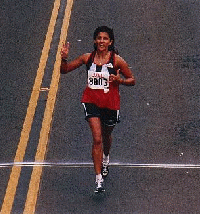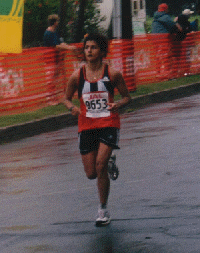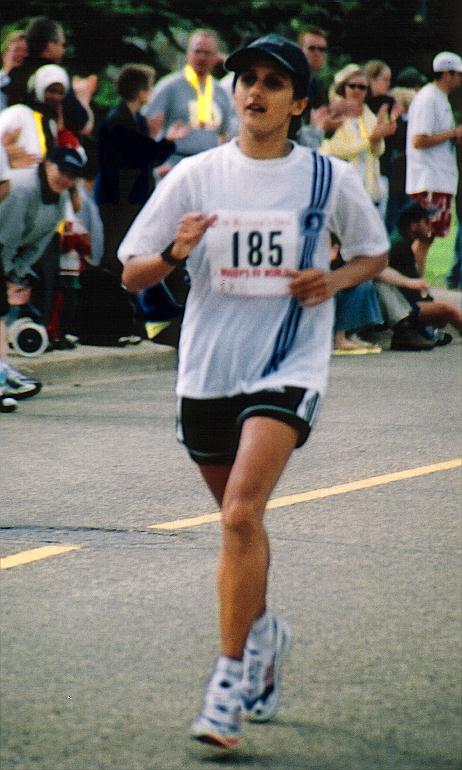| June 2000
Women
in Motion
Newsletter

enhancing
female performance
Vol 1.
Issue 11
June 2000
WOMEN
IN MOTION NEWSLETTER - June 2000
Vol. 1, No. 11
This
Month Contains:
~Articles
Sport Massage
~From
Around the 'Net
1. Therapeutic Massage
2. Make
Exercise Automatic
3. Find
Time to Work Out
4. Marathon
Training Pace Tables
5. Exercising on an Empty Stomach
6. Heading outdoors again?
7. Pass
out motivation
~Words
of Inspiration
~The Running Woman Board
-The
Runner's Club
Advance
Article:
Sport Massage
WHAT IS SPORT MASSAGE?
Sport massage is the manual manipulation
of muscle tissue which determines the tone of the
athlete's muscles. The tone of the muscle is the
proportion of fired (contracted) muscle fibres to unfired
fibres. Massage can adjust the muscle tone to enhance
optimal performance. If the muscle tone is too high,
there may not be enough muscle fibre to contract for peak
performance and if the tone is too low, the athlete will
not get enough elastic response for his/her muscles. If
an athlete pushes too hard with a low tone, there is a
greater risk of injury.
THE BENEFITS OF SPORT MASSAGE:
1. Massage acts as a safety check fo
tight muscles warning the therapist and athlete of
potential areas at risk of injury.
2. Loosened muscles enhance performance
and decrease risk of injury (especially before speed
work).
3. Massage increases circulation,
decreases inflammation and removes fatigue by-products
which restrict optimal muscle performance.
4. Massage increases self awareness of
the athlete's body condition and muscle tone.
5. Massage eases pain caused by tightly
contracted muscles that press on nervous tissure by
relaxing the muscle spasm.
6. Massage hastens the recovery period
from muscle fatigue and injury by increasing circulation
resulting in better nutrition, quicker regeneration and
repair.
WHAT IS INVOLVED IN SPORT MASSAGE?
A. Pre-Event Massage:
In conjunction with an athlete's
regular warm-up, a pre-event massage stimulates
the muscle, the circulatory system and the
nervous system to be best prepared for the
upcoming event.
Pre-event massage is usually of
short duration (10-15 minutes). The muscle tone
is evaluated and then treated to adjust it
accordingly.
The circulatory system is
stimulated to increase the oxygen and nutrient
supply to the muscles that are about to be
worked.
- Stimulating the nervous system allows muscle to
respond faster. This increases the amount of
muscle fibres that are available for action and
at the same time relaxes muscle tension.
* The athlete's body is now prepared
for
maximal output and performance.
B. Post-Event Massage
Massage aids in muscle fatigue
recovery by increasing the circulation, bringing in
nutrition and eliminating metabloic wasts
generated by the working muscle.
Elimination of metabolic wastes
(energy by-products)reduces muscle soreness and
stiffness, by quickly decreasing the muscle tone
that is caused by muscle fatigue.
Post-event massage relaxes the
central nervous system which also relaxes the
muscle.
Post-event massage helps the
athlete's muscles to relax quicker resulting in
fewer negative after effects following strenous
physical activity.
C. Maintenance and Rehabilitation
Massage:
Regular massage keeps muscles,
tendons and ligaments in optimal condition which
helps prevent injuries.
When muscles are loose they are
better able to uphold the stresses of training
and are less prone to tears.
Acute injuries are treated with
appropriate hydrotherapy, massage and remedial
exercise to avoid fibrosing adhesions and
scar-tissue build-up. This allows the injuries to
heal faster and stronger which helps prevent
chronic problems from developing.
HOW MASSAGE SPEEDS THE RECOVERY PERIOD OF
INJURIES
Reduces swelling to speed the
healing process by restoring the flow of
nutrients to the wound.
Helps prevent the formation of
scar-tissure adhesions. Adhesions are both
stronger and less supple than the surrounding
tissue. This increases the risk of new muscle
tears adjacent to the original injury site.
Increases the circulation to
remove wastes from the injured area.
HOW MASSAGE CAN HELP ALLEVIATE NAGGING
CHRONIC INJURIES:
Muscles will automatically
tighten around an injury to support and protect
the area. If continuous micro-tearing and
re-injury is occurring, or there is a larger
uneven soft tissue tear (in ligaments, tendons or
muscles), the dbody will eventually lay down scar
tissue at the injury site. The connective tissue
fibres become adhered to the muscle fibres which
shortens the muscle and prevents adequate
circulation from reaching the injured area.
Massage helps to breakdown the scar tissue to
properly align the scar tissue with the muscle
fibres.
If the injury is in a chronic
state, then the muscle has been contracted for a
long period of time. This often causes numbness,
tingling and/or increased pain from compression
on adjacent nerves. Manual manipulation and the
loosening of the muscle will help the muscle
fibres to relax and prevent nerve compression.
Often with chronic injuries other
muscle aches develop. Surrounding muscles may
compensate for the inability of the injured
muscle to perform its required activity. Massage
can help by relaxing these tense overworked and
misused muscles.
| Good Luck and Great Runs Gord
- Women in Motion
|
        
FROM AROUND THE 'NET
1. Therapeutic
Massage
Sports Massage is
being used more and more by athletes and coaches
as a means to enhance performance. Check to see
if it will work for you.
Link: http://sportsmedicine.about.com/health/sportsmedicine
2. Make
Exercise Automatic
People who stay faithful to exercise plans have
established a routine. Exercise is like
brushing their teeth. They just
get up and do it. You can too, with these
step-by-step instructions:
Check this link: http://www.prevention.com/weight/buzz/automatic/?c38
3. Find Time to
Work Out
How do you start an exercise routine when you
have children, work full-time and go to school?
Prevention Fitness expert Michele Stanten has the
answer:
Follow this link: http://www.prevention.com/weight/gym/980114.gym.html?c38
4. Marathon
Training Pace Tables
Pace tables provided
for determining appropriate training paces for
runners of various abilities. Each table
contains: (1) A realistic marathon goal and pace,
(2) An estimated
maximum aerobic pace and
(3)"Easy"
training speeds from 2-25 miles.
http://teamoregon.com/~teamore/publications/marathon/training.html
5. Exercising
on an Empty Stomach
Muscles require energy. This energy is
found in glucose (blood sugar), glycogen (sugar
stored in the muscle), or body fat. When
exercising, the body uses glucose circulating in
the blood for energy. If you have not eaten, your
body will not have the available glucose and will
take glycogen from the muscle cells. The result
is a tired feeling and a lack of muscle
endurance.
Fat is not immediately burned as you might think.
The body conserves fat during times of
deprivation. The metabolizing of fat is a last
resort and usually does not occur for the first
24-48 hours of lowered glucose levels.
6. Heading outdoors
again?
With spring here,
many of us are looking forward to heading back
outdoors and having a good run around the block.
Remember to start back gradually and increase
your distance as your endurance improves. You do
not want to get an injury this early in the
season.
Running, as well as walking (11:00 mile pace), is
beneficial to many muscles. This helps reduce the
amount of fat stored around the muscles. Perform
strengthening exercises three times a week to
give specific muscle groups attention. Basic
crunches will help tighten that group of muscles,
but the fat will not melt away by doing crunches.
Fat will only melt away if you burn more calories
than you consume, which allows your body to
attack the fat for energy.
As you run, remember to keep your posture
straight and work those abdominal muscles along
the way. Not only will you look better,
but also you will feel great. Make sure your
shoes are in good shape and not worn out when you
put them away last season. Dress appropriately so
you don't get too hot or stay too cold.
7. Pass out
motivation
When you're out
driving around, biking or running
yourself, and you see another runner, no matter
how bad or good he, or she,
may look, give them a little word of
encouragement. A little goes a long way.
Words
of Inspiration

"You
didn't beat me.
You
merely finished in front of me."
-Hal
Higdon, runner and writer
(for my
wife and her eleven seconds - Gord)
The
Running Woman Message Board in Diet and
Fitness
The Running Woman
Message board continues to be active. The
number of posts have dropped back to the
usual 40-50 posts each week. Obviously
the good spring season has members out
and running rather than spending time
sitting in front of the computer. Even
the past few newsletters are slow in
being prepared as 'I'd sooner be running'
phrase says. A large number of new
newbies and wanabees have asked for help
in getting started. Thanks to all of you
who have provided assistance. Good Luck
and Continued Running to all.
Gord
The Runner's Club
The RUNNER'S CLUB is
still quiet, but with the number of
members increasing daily. We are still
having problems with but with incorrect
email addresses.This makes it difficult
to communicate with all members. If you
are a member, please take the time to
ensure that your email address is the one
you want to use.
Two features of the CLUB
still remain the ability of members to
communicate with each other privately in
the CLUB and the ability to arrange to
chat with each other in the 24 hour chat
facility.
Good Luck and Great Runs
Gord - Women in Motion
About This Newsletter
A reminder that experts
- we are not. Information presented here
is a collection of research with a taste
of experience and opinion added for
flavour. We don't get upset if someone
disagrees with anything that has been
said or written. In our experience with
running groups here at home, it is
difficult to get agreement on most
anything. If it works for you, then it
works.
Neither
Women in Motion nor the author of this
newsletter provides professional medical
advice. The information in this
newsletter is intended to help you better
understand running issues. It is not
intended to replace the advice of a
physician. If you read something in the
newsletter that contradicts what your
physician tells you in any way, always
follow your physician's advice.
SUBSCRIBE/UNSUBSCRIBE
INFO
You are receiving access
to this newsletter because you have
subscribed via Listbot. If you
do not wish to have future newletters
sent to you, please use that same system
found on the home page to unsubscribe.
If you have any
suggestions for topics or questions
please email us. We would like to publish
a monthly newsletter that reflects the
interests of the female runner.
Gordon Samson, Editor
Women in Motion
LEGAL
STUFF / SUBSCRIPTION INFO.
"Women
in Motion Newsletter" is free, but
its contents are
copyrighted. No one may use the content
without permission of
the author and "Women in
Motion". So please let us know if
you
think the information here is important
enough to be re-written.
Spread
the Word
Tell your friends they can get the email
link to this free monthly newsletter.
Gordon
and Fariyal Samson
Women in Motion
Visit us at
run.to/womeninmotion
Practice
doesn't make perfect, perfect practice
makes perfect.
-Fariyal
Samson, B.PE, B.Ed
 © Women
in Motion -June1.2000 © Women
in Motion -June1.2000
|
| |
|
| |




